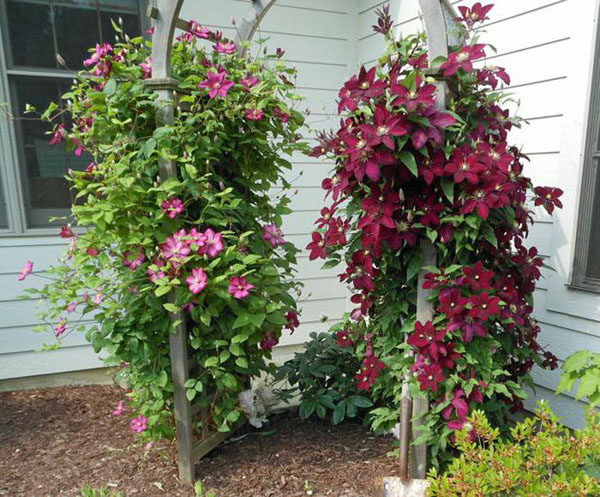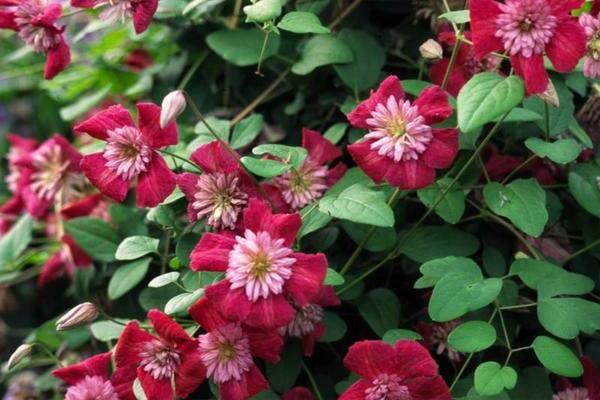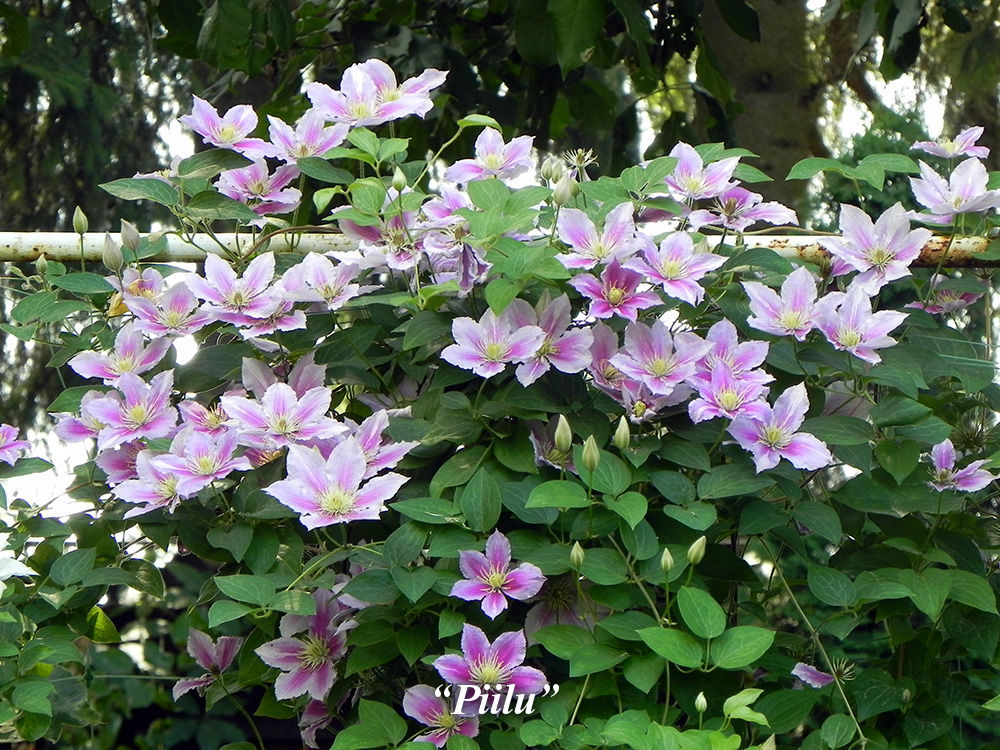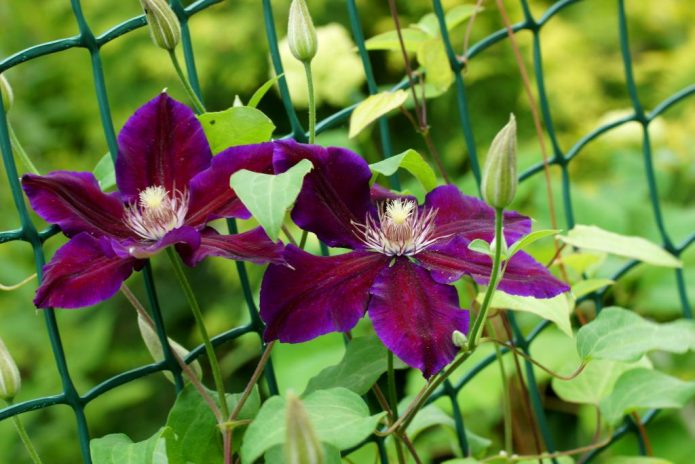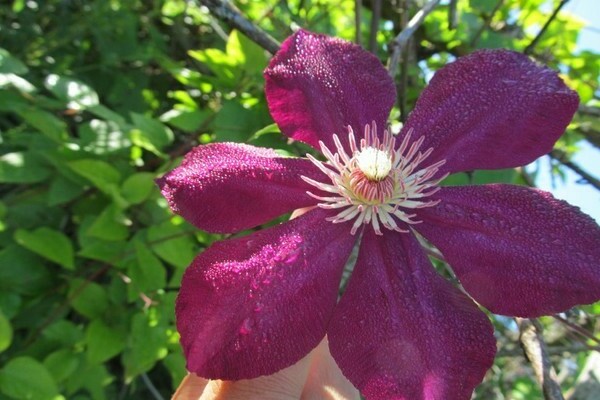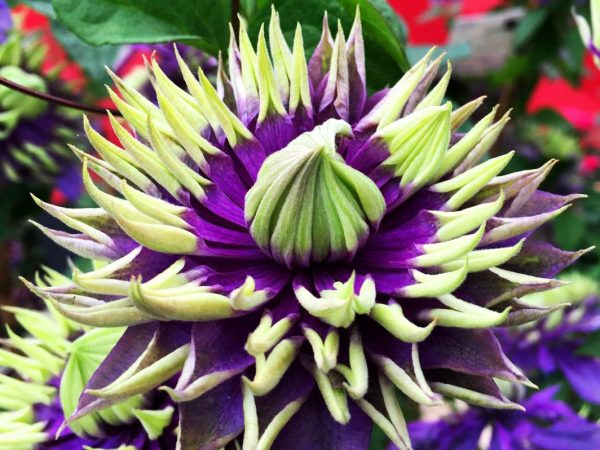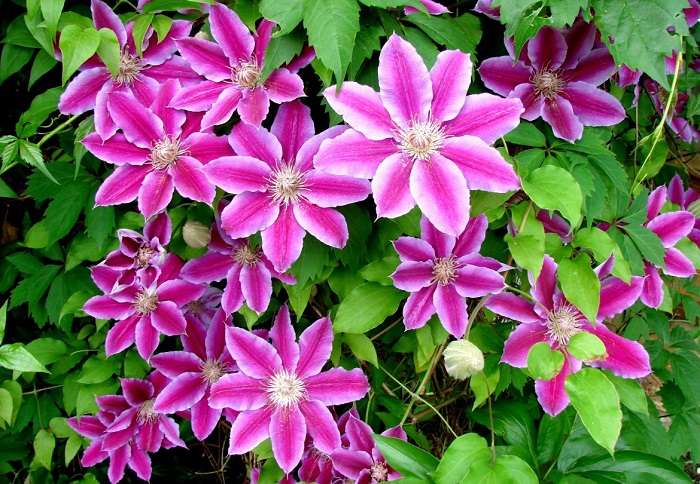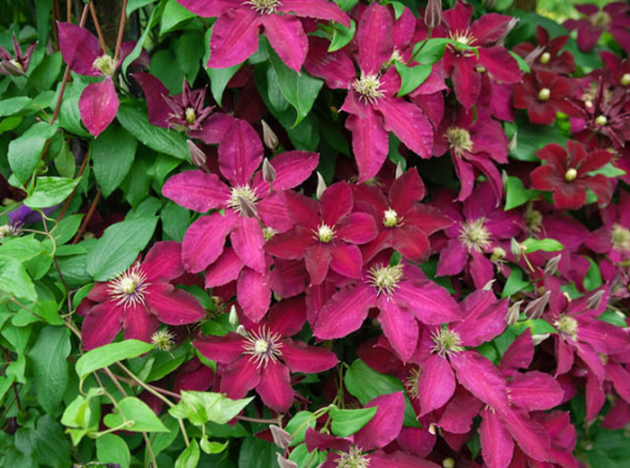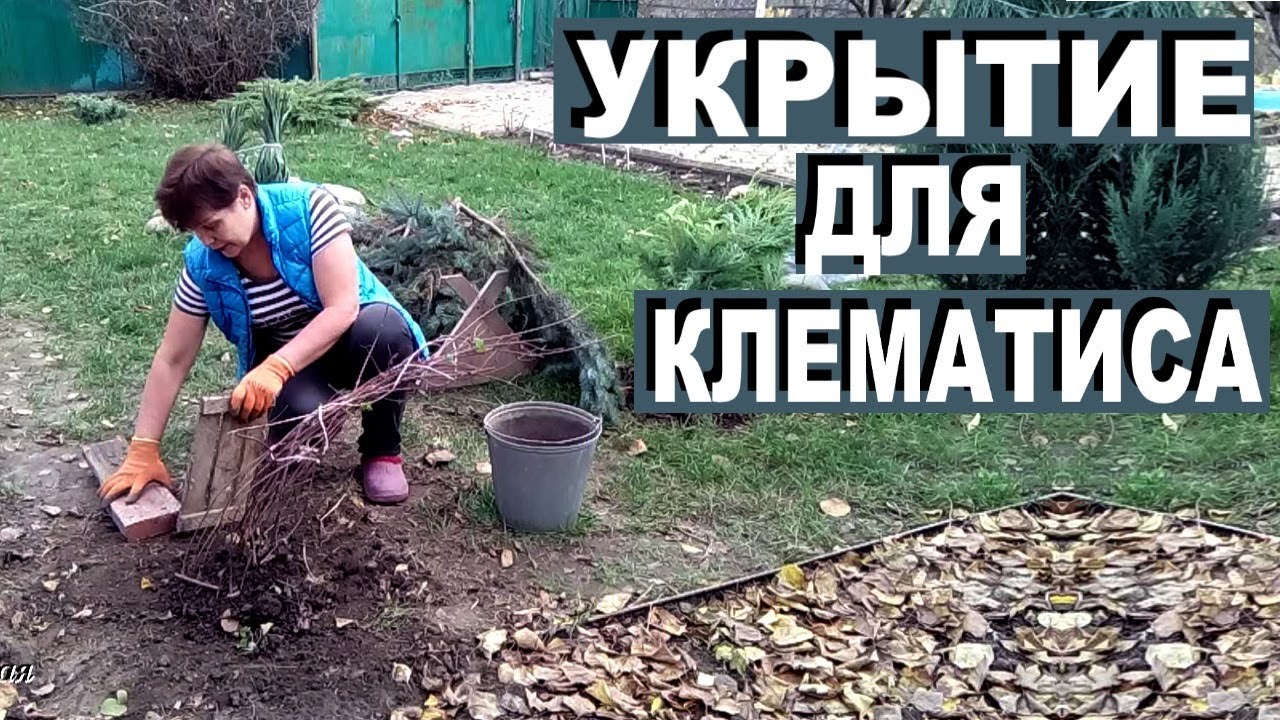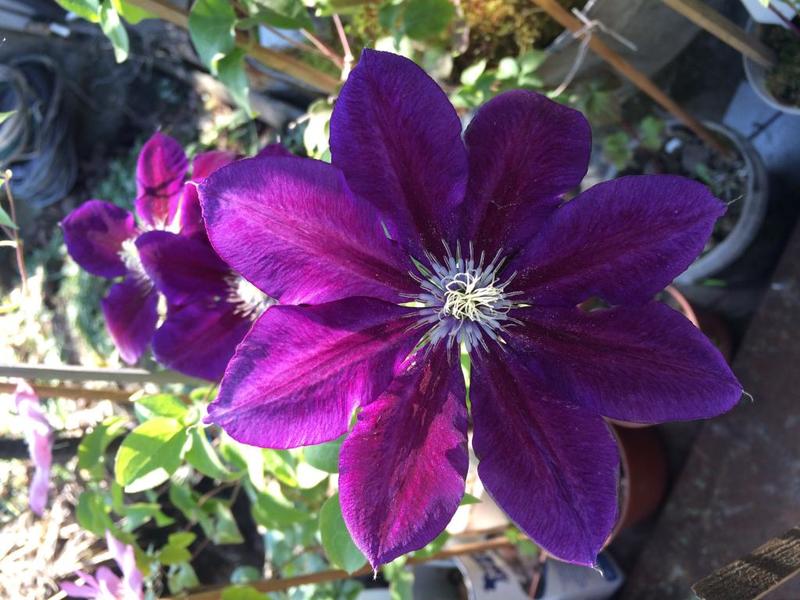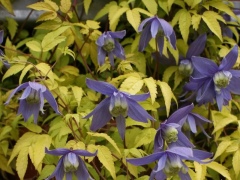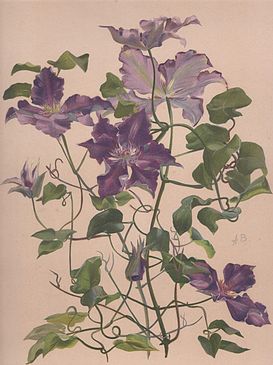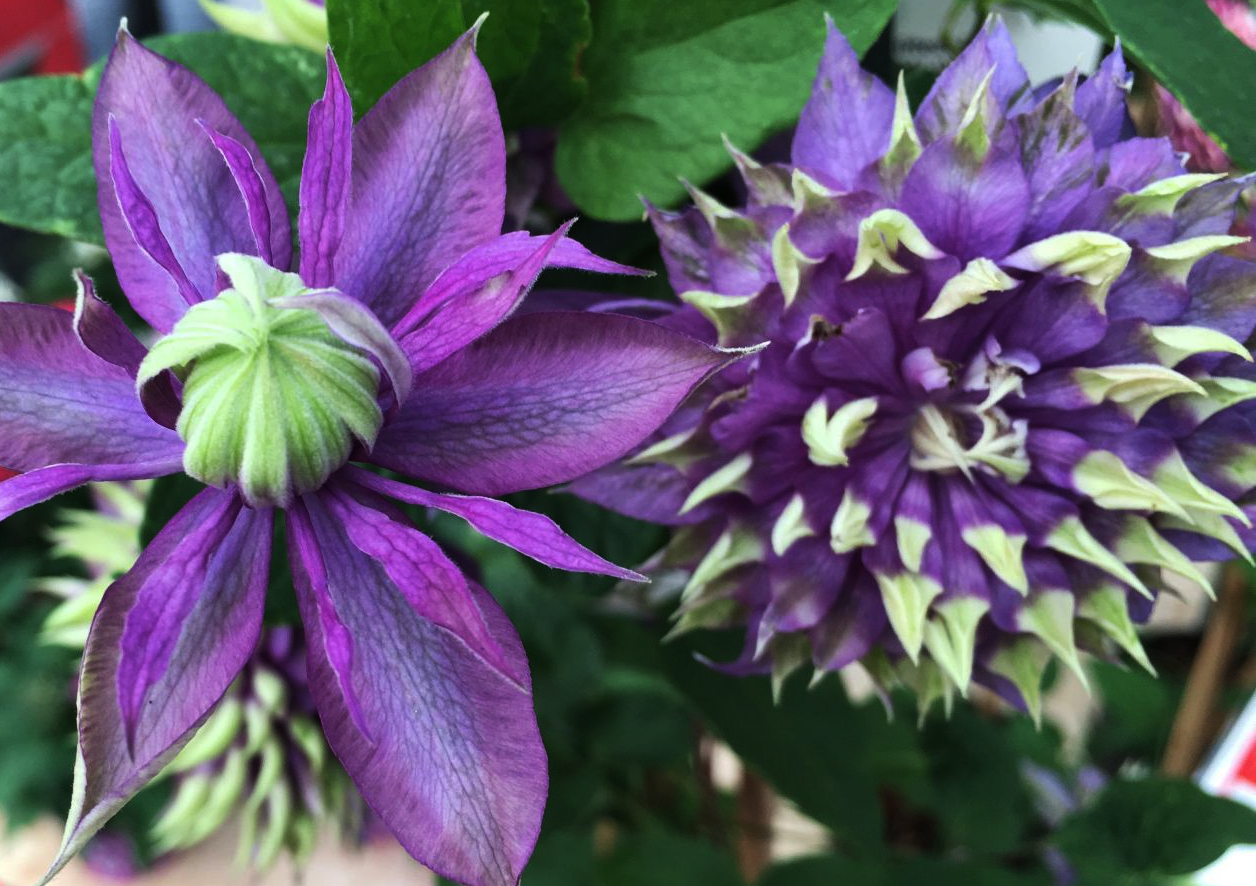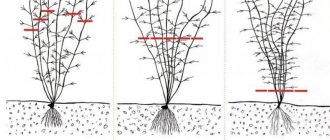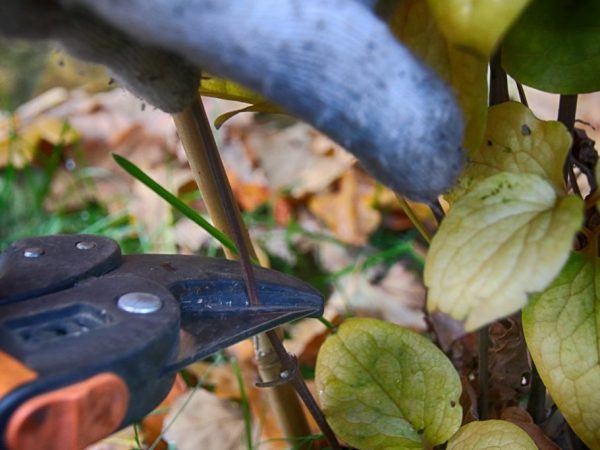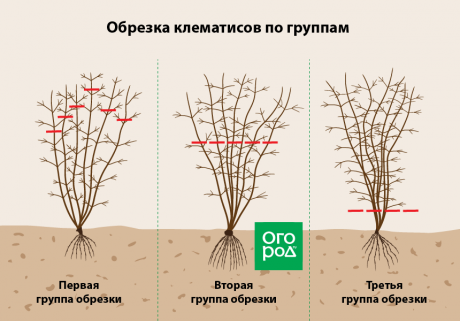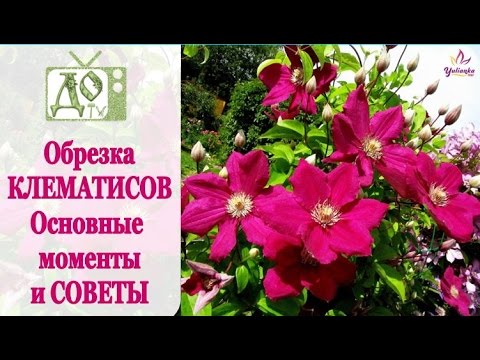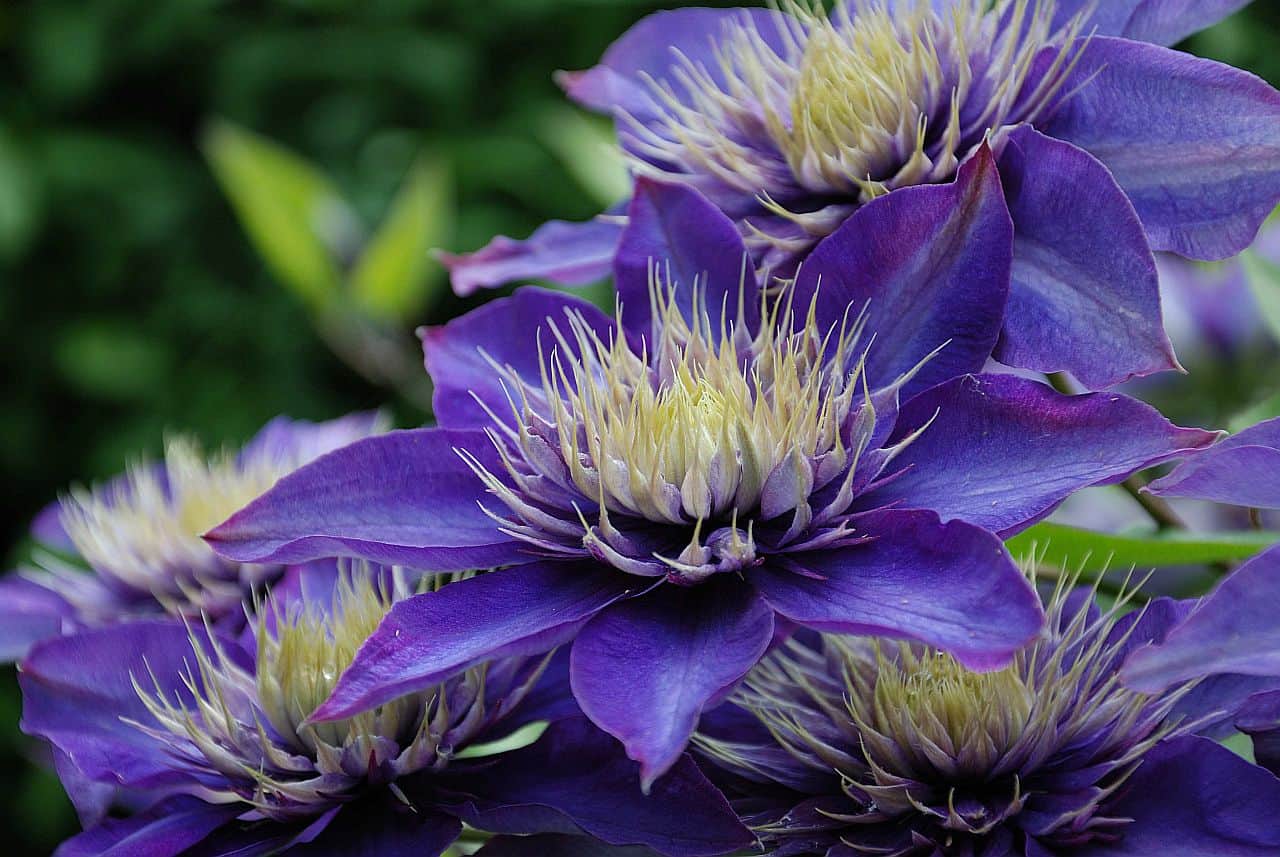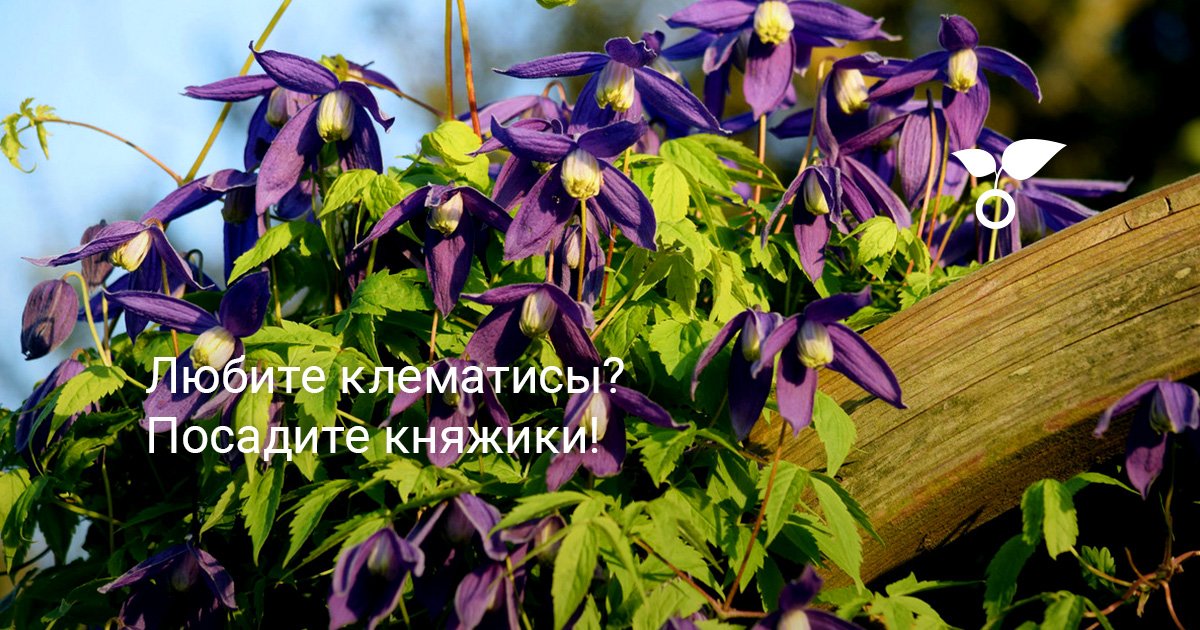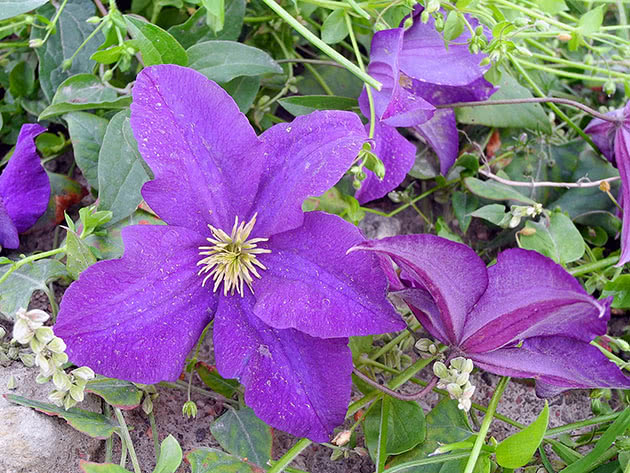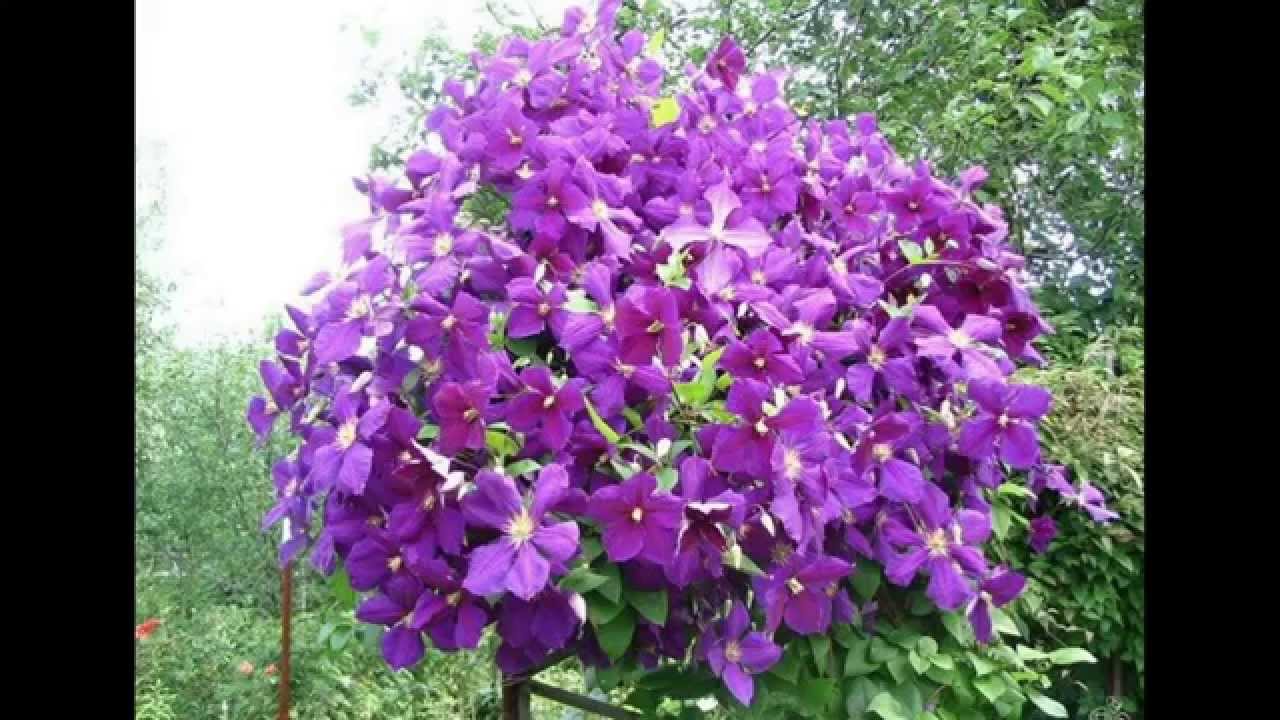How and when to trim correctly?
It is believed that pruning clematis in groups is more relevant for specialists, and amateurs, and especially novice gardeners, need not delve into the intricacies and adhere to general rules. In the fall, the shortening of the shoots is the same, regardless of the group. For the winter, it is better to shorten the shoots so that one or two buds remain above the ground. This allows the root systems to wake up faster in the spring, and then bloom more actively.
It is customary to combine pruning with pinching; it can be carried out in the summer at the beginning of June. This procedure promotes better branching of plants. If clematis belongs to the first or second group, then it should be pinched so that 30 centimeters remain from the ground to the selected mark. Further, when the lashes grow up, the height should be increased to 50 centimeters. Clematis from the third group are pinched for the first time at a height of fifteen centimeters, then at around 20-30 centimeters, and then at a height of half a meter.
The pruning itself is carried out using a conventional pruner or a sharpened knife. The cut should be done in such a way that at least 5 centimeters remain between it and the nearest kidney.
It is important to make an oblique movement of the tool so that moisture does not remain in the resulting place, which can provoke the appearance of rot
In addition, we must not forget about the disinfection of the point, especially if one plant is processed after another.
As a rule, a healthy and properly developing clematis has 10 to 15 lashes. However, in some species, the number of shoots is significantly increased, and therefore they need to be thinned out in order to avoid thickening. It is better to do this after clematis has flowered. All plants also require sanitization, which can be done regardless of the season. Broken or diseased branches are removed immediately.
By the appearance of clematis, it is almost impossible to determine which group it belongs to. In most cases, the only way to find out is to check with the seller or read the label. However, experts believe that the double petals of the buds are characteristic only for the second pruning group. Small-flowered clematis in most cases belongs to the first group. If in doubt, it makes sense to carry out a combined pruning and empirically determine which group clematis still belongs to.
Spring pruning is carried out at the beginning of the season, as it is necessary to be in time before the buds awaken and the juice begins to move. At the same time, sanitary and thinning treatment should be carried out. Many gardeners prefer the spring procedure, as this gives a clearer understanding of how much the plant should be shortened, which buds have already woken up, and which ones are frozen in winter and must be removed. Upon completion of the procedure, clematis is immediately attached to the existing support. Autumn pruning takes place anywhere from mid-October to late November.
The choice of the date should be carried out in such a way as to have time to complete everything before the onset of frost. Despite the fact that not all groups of clematis need processing for wintering, it can be carried out in any case, but with the aim of thinning the branches and implementing sanitary prevention.
Reproduction of clematis by seeds: at home and in the open field
Clematis is at the peak of popularity and is rightfully considered the king of vines, decorating gazebos, terraces, pergolas and fences. The plant is not picky, it feels great in flower beds and in the garden. At first glance, clematis conquers with the original color of its leaves and gorgeous flowers.Some ornamental varieties boast abundant flowering - up to two hundred buds per plant. Seed propagation allows improving varietal performance or even developing a new variety of clematis.
The best time to plant clematis seeds
Gardeners do not always have the opportunity to purchase seedlings of Lomonos (another name for the plant), so they resort to seed reproduction. When growing clematis from seeds at home, sowing is recommended in the autumn. During the winter, the seedlings will grow and get stronger, and in the spring they can be safely planted in open ground.
When to sow clematis seeds? Sowing seeds immediately after collection is not recommended, they should lie down for a while. For large-seeded varieties, this period is 2.5-4 months, and for small-sized grains, 2 months will be enough.
How to grow clematis seedlings at home
Before sowing, it is imperative to carry out preparatory measures. First of all, this is the stratification of clematis seeds, which allows you to grow strong seedlings at home, with disease-resistant immunity. This procedure involves keeping the seeds for some time on the bottom shelf of the refrigerator. On average, this period is about 3 weeks.
On this topic:
BACK
FORWARD
1 of 89
The right choice of soil is an important condition. The soil mixture should consist of garden soil, humus, sand and ash. The substrate can be purchased at a flower shop or you can make your own. How deep to embed the seeds is determined, guided by their size. According to the rules, the planting depth should be twice the size of the seeds.
From above, the crops are sprinkled with sand and lightly compacted. Thus, seed germination is accelerated. Germination times depend on the clematis variety and the specific growing conditions. On average, the appearance of the first shoots takes from 3 weeks to 3 months.
Outdoor cultivation
When to plant clematis seeds for seedlings when growing vines outdoors? The best time is early spring. First, the seed should be kept in the refrigerator for about 3 months.
Small seeds can be sown directly into the ground without prior stratification. The sowing depth of small-caliber seeds is about 1 cm. The first shoots should be expected in 1.5-2 months. Large seeds should be soaked in warm water for a while. Withstand them for 3 days, while changing the water every day. You can also carry out bubbling of seeds - pre-sowing treatment in water with oxygen. This procedure increases seed germination, enhancing growth processes.
Another option for propagating clematis by seeds is winter sowing in seedling containers or boxes. In the spring, immediately after the appearance of the first leaf, the seedlings are transplanted to a bed with light, loose soil. Youngsters can be moved into ordinary garden soil after the appearance of 1-2 pairs of true leaves. Immediately after transplanting, the seedlings should be pinched, just above the second pair of leaves, which will help accelerate growth.
On this topic:
BACK
FORWARD
1 of 46
Autumn sowing of clematis is the most popular among flower growers, as it allows you to enjoy their first flowering already in the new season. But, in this case, you should take care of the reliable shelter of crops for the winter. Film and straw can be used as a covering material.
Browse varieties by group
In clematis, it is customary to distinguish three main groups, according to the rules of which autumn pruning is carried out.
The description of the first group should begin with the fact that it unites those varieties that bloom at the junction of spring and summer on shoots left over from last year. For example, we are talking about such types of clematis as Siberian, mountainous, and also Alpine. These plants do not require shelter at all, and therefore they do not even have to be cut before the onset of frost.However, gardeners still carry out light processing at the end of flowering, freeing the shrub from diseased and weakened branches, as well as shortening the shoots in case of excessive height.
The first pruning group includes representatives of the Atragene species group. Its varieties are formed, which are the result of the selection of various mountain species, for example, Alpine, Korean, Okhotsk, mountain, Siberian, large-petal and Turkestan. All of them are able to survive frosts down to minus 40 degrees right on the trellis.


NS the second group of pruning includes clematis, the buds of which bloom both on last year's shoots, and on fresh ones. Plants should be pruned twice a year. The first pruning is carried out on last year's shoots after the buds have faded. This is done either in May or in June, and it is last year's shoots that are removed - the fresh ones should not be touched. The second pruning is arranged in the fall after the first frost, but even before the plant has been prepared for wintering. All thin, diseased or weakened shoots of this year are cut out completely, and strong ones are shortened by one third. Further, all the shoots are rolled up in rings and laid out on the ground, after which the clematis is covered with spruce branches or special material.
Large-flowered hybrids of this group come from the species "Patens", "Florida" and "Lanutinoza". In autumn, they are shortened so that 10 to 15 nodes remain on the shoots, which corresponds to a one and a half meter plant height. In an adult specimen, only 10-12 healthy shoots are left. We are talking about the varieties "Doctor Ruppel", "Yulka", "Gladys Picard", "Akaishi", "Solidarity", "Sunset", "Miss Bateman", "Asao" and others.
The third pruning group unites clematis, which bloom only with fresh shoots, and the buds are plowed up from July to September. We are talking about representatives of the varieties "Vititsella", "Integrifolia", "Orientalis", "Zhakman". The shortening of the shoots is carried out to the maximum extent in order to ensure abundant flowering for the next season. Shoots are cut so that only 2-3 knots are left, moving from the ground. If clematis has not yet crossed the second year of life, then strong pruning is recommended, regardless of which group it belongs to. In this case, we are talking about the varieties "Varshavskaya Night" (or "Varshavska Nike"), "Vititsella", "Pink Fantasy".
Combined pruning is recommended for some clematis of the "Lanuginoza" subspecies. The fact is that in June the buds open on last year's shoots, and in the middle of summer they bloom on the current branches. You have to combine trimming of the second and third groups. In autumn, fresh shoots are slightly shortened and removed under cover, but old branches are almost completely eliminated as soon as they fade. According to another principle of combined pruning, the shortening occurs in such a way that three tiers are formed.

How to save a clematis seedling before planting
In order for the planting material to be in good condition at the time of planting the soil to a permanent place, you need to take care of its storage at home (in an apartment or a private house).
To begin with, it should be noted that clematis planting material can be found in different forms:
Annual seedlings with a closed root system (Z.K.S.). They are often sold in cardboard boxes. The photo shows an instance in a pot:
Annual rooted shoots with an open root system (O.K.S.). Most often they are sold in a bag in a peat substrate. In the photo they are without a package:
The rules for storing rooted clematis cuttings before spring planting in a permanent place are very simple. First of all, you need to get it out of the bag with peat, carefully examine it. If there are damaged or rotten roots, then they must be cut to healthy tissue, and then soaked in some kind of fungicide, for example, Maxim, Fitosporin-M (according to the instructions).
The rooted stalk should be transplanted from a bag of peat into a 2 liter cut plastic bottle (drain holes should be made at the bottom). It is necessary to use fertile soil. Then, when the optimal planting time comes, you need to dig the stalk right in the bottle in the garden. In this form, it must be overexposed for a year. During this time, the rooted stalk will build up the root system, develop, and the next year you can dig it out, take it out of the bottle and plant it in a permanent place in its normal form. Do not forget to take care of it, water it.
But it is recommended to buy a clematis seedling with a closed root system in a pot no earlier than 3-4 weeks before planting in a permanent place. To successfully save the purchased clematis seedling before spring planting in open ground, you must follow the following rules:
- Immediately after the purchase, you cannot put the seedling in the sun, it is already weakened and unnecessary stress and sunburn is not needed. Let the plant stand in a room with diffused sunlight for 3 days. And then you need to put on the sunniest place in the house. The recommendation is also relevant for the cutting.
- If you see buds on the seedling, then after buying you need to cut them off at home with a clean, disinfected knife. If the buds are left, it will be an additional load for the seedling and it will be more difficult for him to adapt to a new place after transplanting into open ground.
- Water regularly while maintaining a moderate soil moisture. Remember to check soil moisture daily.
- It is recommended to water the plant with a fungicide solution, for example, with Fitosporin-M. Watering is done every 7 days. Manipulation will help to avoid disease and mold growth of the seedling. It is also recommended to spray the root zone with a solution. The advice should be applied to the cuttings as well.
- If you have bought a seedling and the recommended planting time is not coming soon, then you can transplant the seedling into a larger container (for example, a cut 2 liter plastic bottle with drainage holes or a tall one and a pot). The soil must be fertile. Transplanting into a larger container will make the seedling overexposure more comfortable.
- If your seedling is completely sad - weakened, wilted, then you can cheer it up by feeding. As a fertilizer, you can use a complex preparation, for example, Agricola, Fertika-Lux, Biohumus (you need to follow the instructions). Also relevant for cutting.
Planting and leaving
To grow a garden culture that blooms from May to September, it is necessary to carry out timely and correct work on planting seedlings in open ground.
Seat selection
The correct choice of a place for planting flowers will ensure active development and abundant flowering of clematis.
- For planting plants, they choose sunny, dry areas on small elevations.
- Garden culture does not tolerate strong winds and drafts.
- If there are close deposits of groundwater on the site, then the place for planting flowers must be raised by 15-20 cm. Otherwise, the plants are exposed to excessive moisture, which will serve the development of fungal diseases and rotting of rhizomes.
- Plants planted close to buildings also suffer from excess moisture that gets into the soil from the roof.
Advice! To protect the root system of clematis President from severe overheating, annual flowers are planted around the bushes, which shade the plant.
Soil preparation
The composition of the soil determines the growth and flowering of the horticultural crop. Therefore, clematis are planted in a previously prepared fertile, loose soil with a low acid content. Peat, sand and mineral fertilizers are added to the well-loosened soil. Soil preparation is carried out in advance, 2-3 weeks before planting.
The choice of planting material
If the planting material is grown independently, then before planting in open ground, the rhizomes are disinfected with special means.
But when buying seedlings, first of all, they examine the root system of the plant.It should be free from damage, putrefactive deposits, seals and not overdried. There should be 2-4 vegetative buds on the shoots. The acceptable size of the aboveground part of the seedling is from 30 cm, with a smooth shoot without damage and manifestations of diseases and pests.
Landing scheme
Blooming liana is a tall and sprawling plant. When planting seedlings, at least 1.5 m of free space is left between the plants.
- In the prepared area or flower bed, dig holes ranging in size from 60 to 90 cm in depth, and the same size in diameter.
- High pegs are installed in the holes that will support the plant.
- A layer of stones or rubble is laid out in the hole. This procedure will prevent moisture from stagnating in the soil.
- Next, a small pile of fertile soil is poured, on which the seedling is installed.
- The rhizomes are neatly laid out in the hole, sprinkled with soil and carefully watered.
Important! When planted in open ground, the root collar of clematis deepens 8-10 cm from the upper soil level
Timing
Planting flowering creepers in open ground depends on the climatic characteristics of the region. In temperate and southern latitudes, a flower is planted at any time from spring to late autumn. But, according to experienced gardeners and florists, the best time to plant flowers is still autumn.
Like any actively flowering plant, clematis needs careful care. Watering is especially important for flowering creepers in hot, sultry weather.
Watering
Watering is done 1-2 times a week, irrigating not only the rhizomes, but also the leaves of the plant. In dry weather, the amount of watering is increased.
Loosening and weeding
So that extraneous weeds do not impede the growth of flowers, they carry out loosening of the soil and weeding. Also, loosening the soil helps the plant to oxygenate the root system and dose soil moisture.
Top dressing
Flowers are fed based on the fertility of the soil on which they grow. Clematis responds well to organic and mineral fertilizers and fertilizing. As a rule, during the entire growing season, flowers are fed 2-3 times, alternating mineral dressings with organic fertilizers.
How to prune clematis for the winter
Large-scale pruning of clematis in the fall is not always done. Its need is determined by two factors: the variety of the plant and its age. Information about what type your vine belongs to should always be indicated on the package with the seedling. If you buy a flower from your hands or threw away the planting container without looking at it, carefully observe the clematis itself or use the universal pruning method.
Clematis should be pruned in late October or early November (depending on the region), and it is better to do this in dry weather
Pruning clematis in the first year of life
In the first year after planting, clematis of all types are cut the same way. A shoot about 30 cm high is left, and everything else is cut off. Such pruning disposes the plant to branching and provokes the appearance of lateral shoots.
Pruning clematis of the first group for the winter
The first pruning group includes clematis that bloom in spring and form buds on last year's shoots. Everything is simple with them - pruning can be performed both immediately after flowering, and closer to winter. You need to cut off the upper 20 cm of the shoot, adjusting the plant to the height of the support, leaving vines up to 2 m long.In addition, every 2-3 years you need to carry out sanitary pruning, preventing the plant from thickening and removing dry or diseased stems.
Janny clematis in the first pruning group
Popular varieties of group 1 clematis: Albina Plena, Ballet Skirt, Janny, Columella, Lagoon, Lemon Dream, Maria Sklodowska Curie, Sen-no-Kaze, Stolwijk Gold.
Pruning clematis of the second group for the winter
The second group of pruning includes clematis blooming on last year's shoots. Such plants are pruned, leaving shoots with a height of 120-150 cm and dried branches are also regularly removed.
Clematis of the Krolowa Jadwiga variety, belonging to the second pruning group
Popular varieties of clematis of the 2nd group: Akaishi, Blue Light, Blue Explosion, Beautiful Bride, Viva Polonia, Guernsey Cream, Innocent Blush, Kaiser, Copernicus, Krolowa Jadwiga, Little Mermaid, Mrs. Cholmondeley, Nelly Moser, Teshio, Hania, Change of Heart, Shin-shigyoku, Jan Pawel II.
Pruning clematis of the third group for the winter
Clematis of the third pruning group bloom only on young shoots, which can grow by 2-3 m during the season. Old shoots are not needed, and they can be cut to a height of 20-30 cm.
Clematis of the Alenushka variety, belonging to the third pruning group
Popular varieties of clematis of 3 groups: Aljonushka, Arabella, Walenburg, Vistula, Grunwald, Danuta, Krakowiak, Madame Julia Correvon, Morning Sky, Night Veil, Paul Farges, Purpurea Plena Elegans, Rhapsody, Roko-Kolla, Romantika, Ernest Markham.
Universal pruning of clematis in the fall
If you already got clematis as adults, and in the fall it turned out that you do not know which group they belong to, follow one of the universal pruning options.
- Divide the lashes of the bush into 3 groups: cut the first short, the second at a height of a meter, and shorten the third just a little, and next year see where the flowering will be better.
- Use combined pruning: cut one shoot up to 1.5 m, and the one growing next to it - up to 2-4 buds. Cut the rest of the shoots through one (short, long, short). This will allow the bush to gradually rejuvenate, and you do not think about varieties and groups.
Be sure to remove clematis with support for the winter - flowers of even the most winter-hardy varieties can be damaged if left to winter on a trellis.
Varieties for the Urals

In order for the vine to fully unfold in all its glory, it is necessary to choose the right variety for each region. The survival rate of the plant and the intensity of flowering will depend on this.
When looking for clematis of 3 groups of pruning varieties for the Urals, you should pay attention to the following categories:
- Zhakman. The group includes bush vines with large inflorescences. Scourges grow up to 4 m long. The plant has a powerful root system. The leaves are pinnate. The flowers are large, about 20 cm in diameter, most often with lilac petals. Inflorescences appear only on young shoots of the current year. If you choose the best clematis of the 3 pruning groups from this category, then Rouge Cardinal, Bella, and Star of India are preferred.
- Integrifolia. A distinctive feature of this group of shrub vines is the limitation of the growth of lashes to 2.5 m. Flowers are formed in a smaller size, up to 12 cm in diameter, in the form of a bell. Flower buds are laid only on young shoots. Old lashes are completely removed at the onset of the first frost. Among the popular varieties in this category are Mrs Cholmondeley, as well as Purpurea Plena Elegans.
- Winzella. Vines of this group can be recognized by the complex structure of the leaves. The flowers grow to a maximum diameter of 12 cm. The petals usually take on a red, pink or purple hue. One bush is capable of throwing up to 100 flowers. The growth of lashes is limited to 3.5 m. Flowers appear on young shoots, which must be completely pruned in autumn. Popular varieties in this category are Ville de Lyon, Prince Charles, Ernest Markham.
To make it easier to choose clematis of 3 groups for growing in the Urals, you just need to pay attention to the belonging of the variety to one of the categories
What are clematis?
Novice gardeners are afraid to grow this crop on their site, motivating their decision with the exotic origin of the flower and the lack of much experience in growing capricious plants. Meanwhile, there are many varieties of clematis for beginners. Small-flowered varieties of clematis are considered the easiest to care for. And also, the lighter the color of the flowers, the more trouble with them. Varieties with purple, violet and blue flowers are recognized as the easiest to grow.
Blue-flowered varieties are considered less moody.
Caring for these vines largely depends on the group to which they belong. The criteria for such a division were the presence of a common "ancestor", the coincidence of the flowering period and the external similarity of plants. There are only 9 such groups, but only 4 are suitable for our climate: Integrifolia, Jacqueman, Viticella and Atragen. Clematis varieties that safely tolerate winters and are suitable for growing in the middle lane belong precisely to these groups. For more information on the classification of clematis, read our article:
What are clematis - an overview of groups, the best varieties (photo)
We figure out which clematis to plant in the garden so as not to lose it.
Good care in autumn - successful wintering
Already at the end of summer, it is recommended to start preparing for the coming cold weather. To do this, you need to take the following steps:
- From the second half of August, it is necessary to stop feeding the plants with nitrogen-containing fertilizers, including complete mineral mixtures, which also contain nitrogen. This applies to both clematis continuing to bloom and the group of late blooming ones.
- In the first half of September, it is imperative to make a top dressing, including phosphorus and potassium. It will strengthen the vine, promote the development of new shoots, and also prepare it for winter.
- Before the onset of constant frosts, in 20 - 30 days, pruning of the bush is a mandatory step. In this case, the air temperature should be approximately +10 degrees.
How to prune clematis of different groups
Each variety has its own distinctive features. Based on them, and on the belonging of the plant to a group by the type of flowering and pruning.
- The largest first group, blooming 2 times per season, is necessarily cut off, but not significantly.
- The second group, which blooms on last year's shoots, is cut off quite a bit and does not form in the autumn.
- The third group of clematis, in which flowering occurs on the shoots of the current year, needs a full-fledged autumn pruning.
Despite the division into groups, the second and third are very slightly different from each other. There are exceptions in both groups, and clematis, which are considered to bloom only on last year's shoots, are able to bloom again on young ones.
Sanitary pruning
This procedure is carried out on absolutely all clematis of any varieties. Even if you are not going to conduct a group formative.
- All fallen and dry leaves must be collected within the growing radius of the bush and burned.
- Dry shoots are also destroyed.
- Last but not least, you should inspect the entire bush and remove shoots that are not productive, give excess density, and also with signs of infections and diseases.
- Some growers then additionally process the vine with 1% Bordeaux liquid or Fundazol.
In clematis belonging to the second group, shoots that have formed in the summer season should be left. And so that the plant does not get sick and does not catch the infection, then it is necessary to remove diseased and dried shoots.
Pomegranates with large flowers of the most popular varieties today are cut, but very little. It is recommended to leave from 10 to 15 healthy buds on the shoot, that is, shoots are left about a meter or one and a half high.
If you do not know what sort of clematis is growing, then do not rush to prune, but wait for spring. Then it will become clear to which group the plants belong - some will have dried shoots, while others will have healthy ones with buds.
This option is also possible: all shoots are shortened by half a meter. Provided that the variety and group are unknown.





